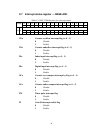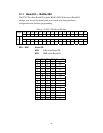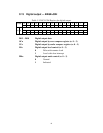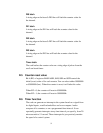
48
Single-ended vs. differential input
Most encoders produce square wave signals with TTL levels. Industrial
systems often use encoder with differential signals, i.e. channel A and
B and their complements. Differential signals can reduce sensitivity to
noise and allow longer transmission distances. Encoders may also
produce a third signal once per revolution know as the index or marker.
The encoder interface can use the index signal to reset the counter,
allowing you to monitor the position within the current revolution.
D.2 Counter modes
The following table shows the maximum input rate for each input
mode and system clock rate. Values are given for each system clock
frequency.
Mode Maximum input rate
8MHz 4MHz 2MHz 1MHz
Quadrature x1, x2, x4 2 MHz 1 MHz 500 KHz 250 KHz
2-pulse 8 MHz 4 MHz 2 MHz 1 MHz
Pulse/direction 8 MHz 4 MHz 2 MHz 1 MHz
Counter modes are as follows:
Quadrature input counter mode
Quadrature input consists of two square wave inputs (A and B)which
are 90° out of phase. The PCI-1784 counts square wave transitions and
determines the direction by comparing whether channel A is leading
channel B or vice versa.
There are three different counting methods in quadrature input mode:
x1 The counter will increment (or decrement) the counter whenever
a rising edge occurs on input channel A.
x2 The counter will increment (or decrement) whenever a rising or
falling edge occurs on input channel A.
x4 The counter will increment (or decrement) whenever a rising or
falling edge occurs on input channel A or B.


















